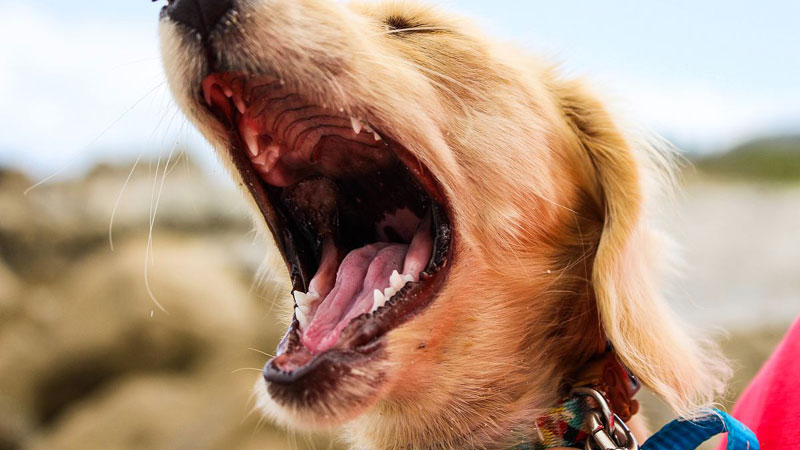- Size
- Smallest
- Small
- Small to Medium
- Medium
- Large
- Giant
- Characteristics
- Smartest
- Hypoallergenic
- Fluffy
- Best Guard
- Best Family
- Best for Kids
- Low Shedding
- Healthiest
- Police Dogs
- Most Calm
- Quietest
- Color
- White
- Black
- Grey
- Brown
- Blue
- Red
- Coat
- Hairless
- Short
- Long
- Origin
- Japan
- China
- Australia
- Germany
- Italy
- United States
- France
- Group
- Hound
- Terrier
- Herding
- Toy
- Working
- Sporting
Different Dog Growls and What They Mean

Growling is a natural vocalization and communication method used by dogs. It serves as a way for them to express their emotions and communicate their needs and boundaries. However, not all growls are the same, and it's important for dog owners and enthusiasts to understand the various types of growls and their meanings.
In this comprehensive article, we will delve into the various types of dog growls and unravel the meanings behind each, providing insights into the complex language of our canine companions.
1. Playful Growling
Playful growling is a common behavior exhibited by dogs during playtime or interactive activities. It's typically accompanied by a relaxed body posture, a wagging tail, and a generally happy and energetic demeanor. Playful growls are usually higher in pitch and have a "gleeful" quality to them.
If your dog engages in play growling, it's important to pay attention to their overall body language to ensure that the play remains friendly and enjoyable for all parties involved. Look for loose and relaxed movements, and make sure there are no signs of tension or aggression.
2. Fearful or Defensive Growling
Fearful or defensive growling is often low-pitched and accompanied by other signs of fear or discomfort. When a dog feels threatened or scared, they may growl to communicate their desire to be left alone or to ward off potential threats. Fearful growling may come from dogs who have had negative experiences or who lack socialization.
If your dog is growling out of fear or defensiveness, it's important to approach the situation with caution and respect their boundaries. Forcing interactions or adding pressure can escalate the fear and potentially lead to more aggressive behavior. It's advisable to consult with a professional dog trainer or behaviorist to address the underlying fear and help your dog build confidence.
3. Aggressive Growling
Aggressive growling is a serious behavior that should not be taken lightly. It is often accompanied by other signs of aggression, such as a stiff body posture, direct eye contact, bared teeth, and raised hackles. Aggressive growling may occur when a dog feels their territory or resources are being threatened or when they are trying to establish dominance.
If your dog is growling aggressively, it's crucial to prioritize safety and seek professional help immediately. Aggression can be complex and potentially dangerous, requiring the expertise of a certified dog trainer or behaviorist to assess the situation and develop a proper behavior modification plan.
4. Warning Growl
A warning growl is a vocalization used by dogs to express their discomfort and to establish boundaries. It serves as a communication method to let others know that they are feeling threatened or uncomfortable and would like the situation to change. Warning growls are usually low and accompanied by other body language cues, such as a stiff posture and direct eye contact.
When a dog issues a warning growl, it's important to respect their boundaries and give them space. Pushing a dog beyond their comfort zone can escalate the situation and potentially lead to aggressive behavior. Understanding and responding appropriately to warning growls can help prevent conflicts and maintain a positive and safe environment for both the dog and those around.
5. Frustration Growling
Frustration growling occurs when a dog becomes frustrated or impatient with a particular situation or when they are unable to achieve what they want. It can commonly happen during training sessions when a dog is struggling to understand a command or during play when they are unable to reach their desired toy.
Frustration growling may be accompanied by pacing, pawing, or whining. It's important to assess the situation and consider whether adjustments need to be made to prevent frustration. Providing clear instructions, breaking down tasks into smaller steps, or offering alternative activities can help alleviate frustration and reduce growling.
6. Vocalization Variations and Individual Differences
It's important to note that dog growls can vary significantly among individuals and breeds. Different breeds have distinct vocalizations, and even within a breed, each dog may have their unique growling style. Additionally, a dog's past experiences, temperament, and overall personality can influence the way they growl and express their emotions.
As a dog owner or enthusiast, it's crucial to spend time familiarizing yourself with your dog's individual vocalizations and body language. Understanding their unique growling patterns and accompanying behaviors will enable you to better interpret their needs and emotions.
Conclusion
Dog growling is a complex form of communication that can indicate a range of emotions, including playfulness, fear, aggression, frustration, and more. It's important for dog owners and enthusiasts to be able to distinguish between different types of growls and understand their meanings.
By being attentive to your dog's vocalizations, body language, and overall context, you can gain valuable insights into their emotional state and respond appropriately. It's crucial to prioritize safety and seek professional guidance if you are unsure about your dog's growling behavior, especially if it is accompanied by signs of aggression or fear.
Remember, effective communication, proper training, and a supportive environment can help foster a strong bond with your furry friend and ensure their overall well-being.
You May Also Like
 Dog BehaviorExploring 5 Common Reasons for Dog Growling Low
Dog BehaviorExploring 5 Common Reasons for Dog Growling Low Dog BehaviorThe 6 Common Motivations Behind Dog Whining
Dog BehaviorThe 6 Common Motivations Behind Dog Whining Dog BreedsThe 10 Dog Breeds with Prominent Hackles
Dog BreedsThe 10 Dog Breeds with Prominent Hackles Dog BehaviorDeciphering Dog Sleeping Positions: The Side Sleeper Pose
Dog BehaviorDeciphering Dog Sleeping Positions: The Side Sleeper Pose Dog BehaviorDeciphering Dog Sleeping Positions: The "Sphinx" Pose
Dog BehaviorDeciphering Dog Sleeping Positions: The "Sphinx" Pose Dog Training TipsHere are the 7 Most Important Dog Commands
Dog Training TipsHere are the 7 Most Important Dog Commands